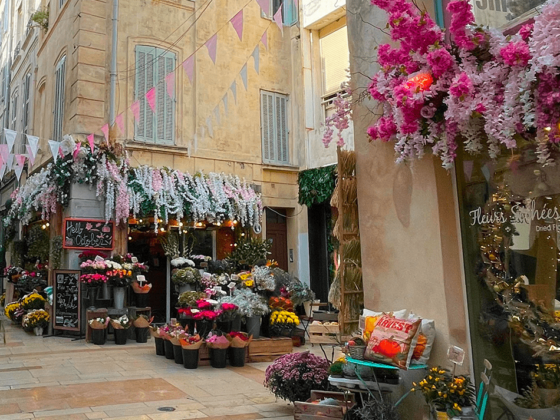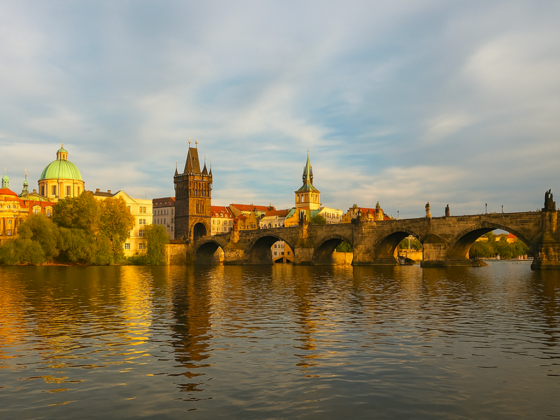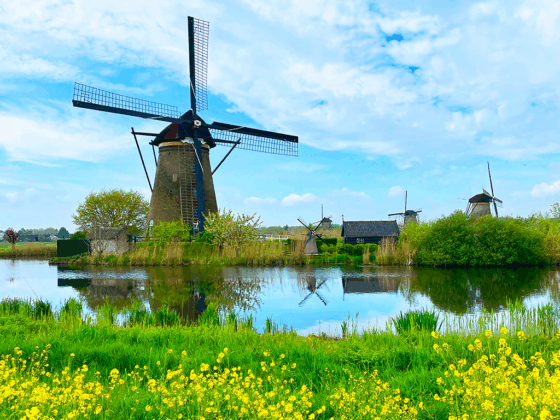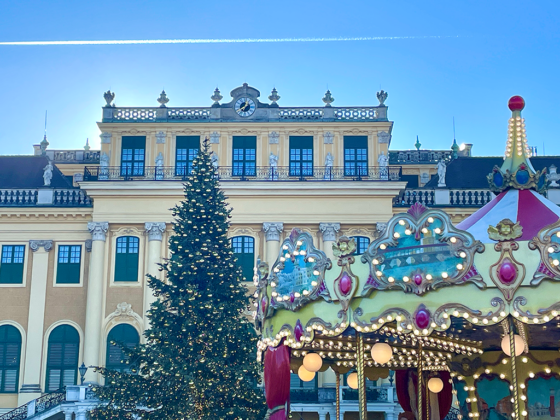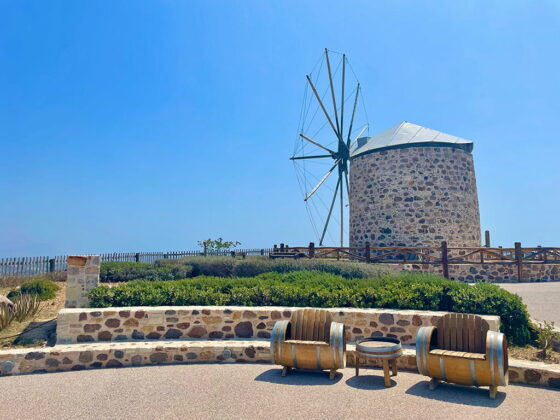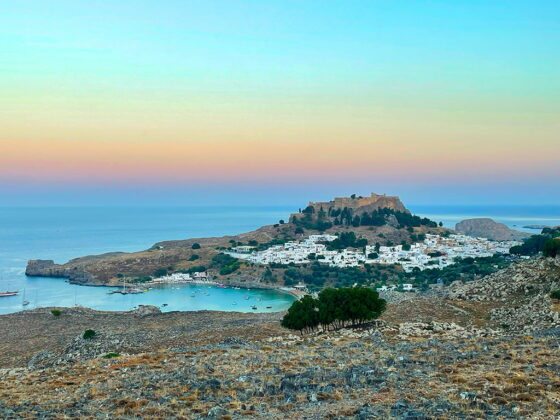After New Year’s we finally have some well-deserved holiday time, which we suddenly won. We need a place that can be reached in a short time and at a high cost, as we could not book and organise in time.
The beautiful castles of Bavaria with a few stops in the neighbouring Tyrol seems like the perfect idea to us! We organise the stops, book the hotels and are ready for a ‘last minute’ tour. Here is our 1400 km-long, six-day itinerary between Germany and Austria.
Map
Day 1: Ettal – Linderhof Castle
We’ve planned everything, we’re loaded, we’re ready… and we wake up late! A wash, a squeeze and we’re in the car in no time. After almost six hours we reach Germany.
Tips for Trips: To get to Germany from Italy we drive through Switzerland and Austria. In both countries you need a vignette to drive on motorways.
The Swiss motorway vignette has a one-off cost of EUR 42 and is valid for one year (there are no daily, weekly or monthly motorway vignettes). It can be purchased in any Swiss or neighbouring country motorway service station and must be placed on the windscreen before entering any motorway in the country. If you cross at Brogeda customs, you can conveniently buy it at the autogrill just before crossing.
The Austrian motorway sticker has three different durations: 10 days, bi-monthly and annual. We purchase the first one at a cost of around EUR 9.40. This too can be purchased at all petrol stations at the border, must be validated by punching a hole in it at the time of purchase and must be placed on the windscreen. In Austria there are also some toll roads, where the vignette alone is not enough and there are classic toll booths to access them. We cross one on the way back to Innsbruck.
Before reaching Füssen, we make a stop at Linderhof Castle in the Graswang Valley. Of the three castles commissioned by Ludwig II, it is the only one that has been completed. Despite being the smallest, it is one of the most sumptuous as well as the most beloved by the Bavarian king who, enamoured of the French style, wanted to transform a hunting lodge into a small palace.
You can only enter the castle by guided tour but, in our opinion, it is not to be missed. Room after room, one cannot help but admire the castle’s opulence and appreciate its extravagance, the result of the king’s eccentric desires. Shy and reserved, he had the Tischlein-deck-dich installed, a dining table that, by means of a system of pulleys, disappeared into the floor to the floor below where the kitchens were located. In this way, the table could be set without the king being disturbed by orderlies during the meal. Nocturnal and industrious, he had the Mirror Room built so that each wall could reflect as much light as possible and he could write at night.
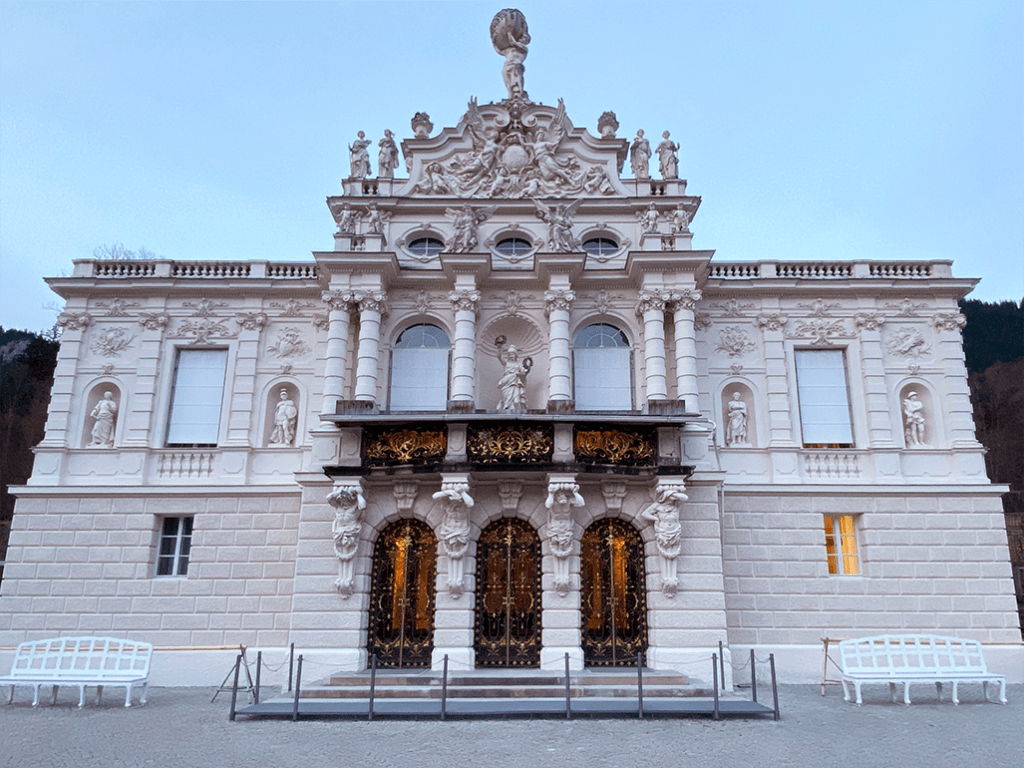
A dreamer and visionary, he built the Grotta di Venere (Venus Cave), an artificial cave with an underground lake where he loved to spend hours meditating on a fairytale shell-shaped boat, lulled by the sound of the water. Underwater lights illuminate the stalactites, creating a very atmospheric dreamlike effect. Due to restoration work, the Venus Cave is closed indefinitely so we are unable to visit it.
Finally, although we were not able to visit it – as it is closed in winter – let us also mention the Castle Park. This seems to be the combination of the king’s attraction to the Orient, the world of medieval chivalry and the splendour of the Bourbon court. Waterfalls, pavilions, fountains and statues embellish the garden, but in winter they are covered to protect them from the cold. We promise to return in summer!
In the evening, we enjoy an excellent Bavarian-style dinner and take a tour of Füssen still illuminated by Christmas lights. The town centre is very quaint, full of half-timbered houses decorated with designs and frescoes, and the shopping streets are decorated with typical wrought-iron signs.
Day 2: Füssen – Neuschwanstein and Hohenschwangau Castles
We wake up very early and set off for Schwangau, today’s programme includes a visit to the two castles of Ludwing II, Neuschwanstein and Hohenschwangau. The interiors can only be visited by guided tour. We tried to get the entrance tickets online, but they have all been taken for several weeks. We do not give up and head to the ticket office anyway. Despite a fairly long queue we manage to get them with enough time between the two to enjoy a tour of the exterior as well.
Tips for Trips: Tickets can be taken in advance online, a part of them is ‘unlocked’ morning by morning, but a remaining part is reserved for visitors directly on site so arriving early there are no problems. Tours are in German or English with audio guides in all languages (also Italian).
We start at the famous and beautiful ‘Fairytale Castle’ of Neuschwanstein. The entrance can be reached by horse-drawn carriages, by bus or on foot along a paved path of about 20 minutes (our choice).
The castle was entirely designed by King Ludwig II, who wanted to create a kind of imaginary kingdom for himself where he could hide and escape his fate. Following the defeat in the Prussian War, Bavaria was in fact dependent on Prussia in foreign policy and the king had to relinquish command of his army, becoming a de facto ‘puppet king’ without power.
The castle can be considered a monument dedicated to the composer, friend and idol of the king, Wagner, who regarded his work almost as a religion. The king committed his entire estate to the construction of the castle. All the rooms are decorated with Wagnerian motifs almost as if the entire structure were a permanent theatre dedicated to music and the arts. An exception is the Throne Room, which recreates a sacred atmosphere resembling a Palatine Chapel in the Norman Palace in Palermo. On the other hand, the top floor is entirely dedicated to the Singers’ Hall, a favourite project of the king, decorated with scenes from the stories of Lohengrin and Parsifal.
Confirming the eccentricity of the sovereign, there is a secret passage between the salon and the king’s study: a small artificial grotto with a waterfall that is also artificial. Next to it is a small winter garden from which one can observe the landscape surrounding the castle. Although the castle is inspired by a medieval ideal, it is equipped with all modern achievements and the highest comfort. The royal residential wing was heated with a central air system. Running water was available on all floors, in the kitchen even hot and cold. The bathrooms had automatic flushers. The king called his servants via a system of electric bells. The dining room was connected to the kitchens (which were three floors below) by a service lift to bring the food still hot to the table.
Of the 200 commissioned rooms, only 15 were completed before the king’s death: he lived a total of only 172 days of his life in the castle.
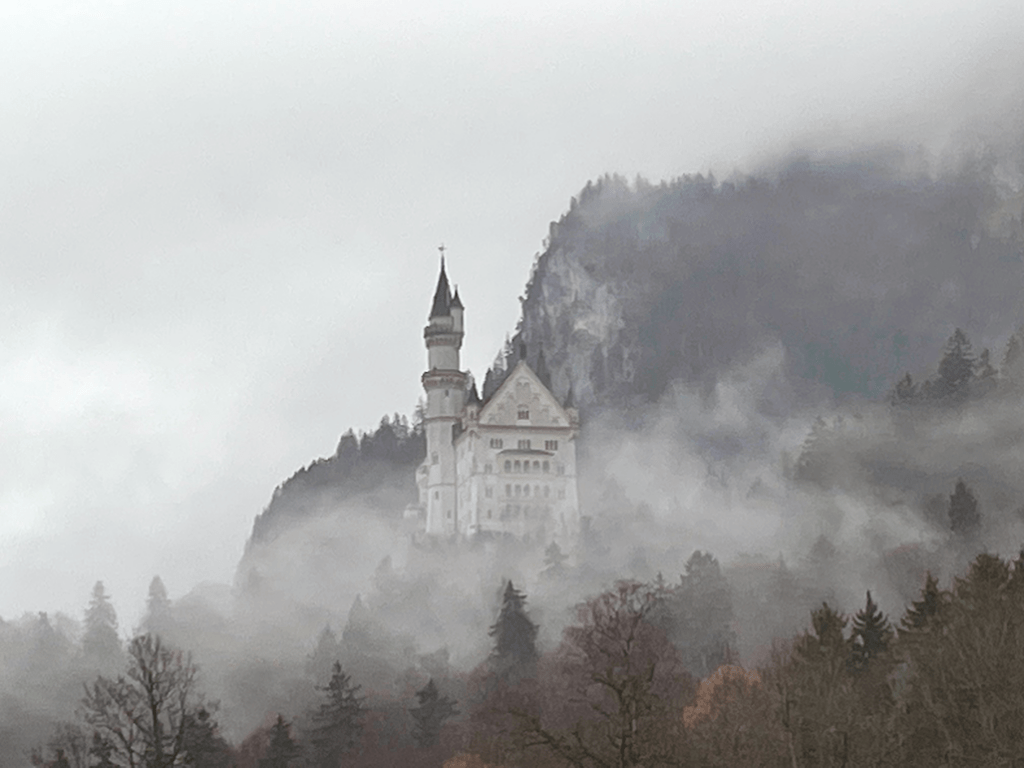
After the visit is over, we head for the Marienbrücke, a bridge spanning the Pöllat Gorge and overlooking Neuschwanstein, offering a breathtaking view of the entire castle. Unfortunately, the fog covers the whole view and we descend to the valley a little disappointed!
SPOILER: Having finished our visit to Hohenschwangau Castle we realise that the fog has cleared and Neuschwanstein Castle is visible again. We run to catch the first bus to the top and enjoy the fantastic view of the castle!
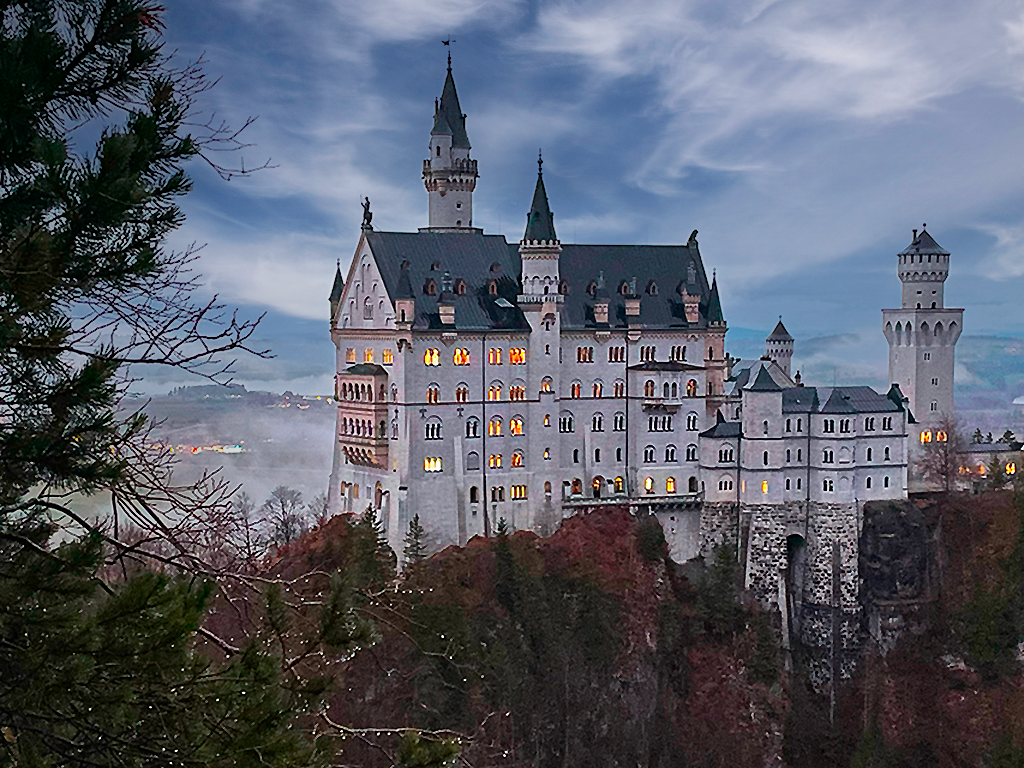
After lunch, we take a tour around the Alpsee lake, which is considered one of the cleanest lakes in Germany. On the southern shore of the lake there is a small establishment that also offers the possibility of a rowing boat tour with a splendid view of the castles and in the colder season the lake turns into a large ice rink.

Time comes for a visit to Hohenschwangau Castle, which can only be visited by guided tour. This, too, can be reached by horse-drawn carriage or on foot via a paved path that runs alongside the forest (30 minutes) or a stairway from the village centre (20 minutes).
It cannot be considered one of Ludwing II’s castles as it was his father, King Maximilian II, who had it built as a summer residence on the beautiful Alpsee lake. It certainly played a decisive role in the Bavarian ruler’s life, probably influencing his dreamy and visionary character: it was here that he spent his childhood and much of his youth, often hosting his revered friend Richard Wagner. And it was here that he came to know, thanks to the pictorial depictions adorning the rooms, the various medieval legends: among them the legend of ‘Lohengrin’, the ‘Swan Knight’, with whom Ludwig later identified himself. When his father died, the eccentric Ludwing II had stars painted on his bedroom ceiling, illuminated by hidden oil lamps. This is the only alteration he made to the castle.
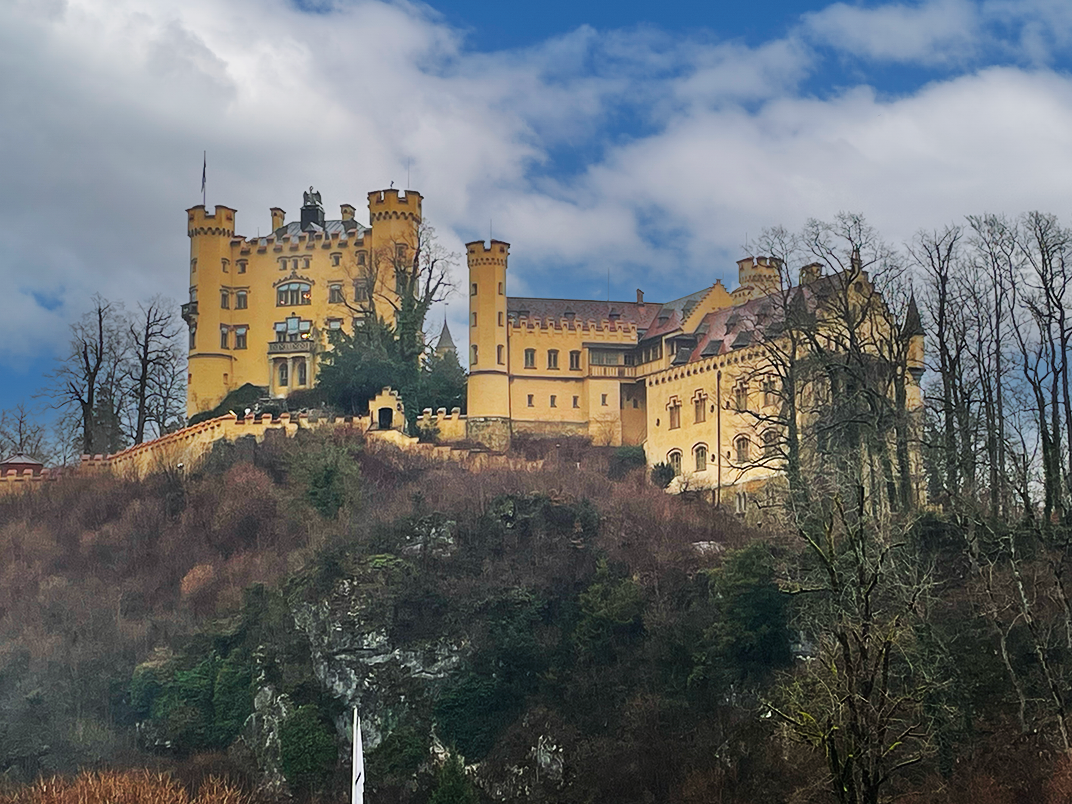
Happy we get back in the car, heading towards Munich. For dinner, we make a small diversions and stop in Oberammergau, a small village made very characteristic by its houses beautifully frescoed with scenes depicting the best-known fairy tales.
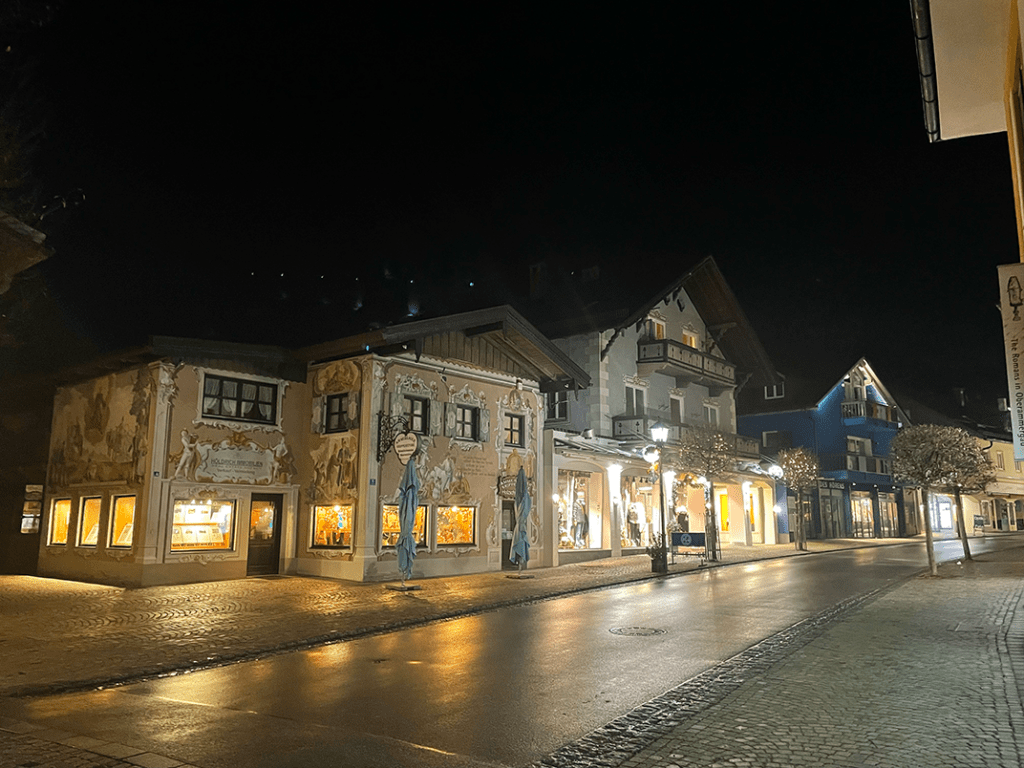
Day 3: Munich
Munich is the most important city in Bavaria. It is a cosmopolitan city that has managed to go beyond the traditional Bavarian spirit while preserving old traditions. Although it is well known for the traditional Oktoberfest, it is a city worth visiting at any time of the year. At Christmas time, it is filled with lights, markets, ice rinks, food stalls and tall Christmas trees.
Odeonsplatz metro stop, where our tour begins.
On the way out, the tall and majestic Feldherrnhalle, built between 1841 and 1844 by architect Friedrich von Gärtner for King Ludwig I as a tribute to the glory of the Bavarian army, stands before us. From here we pass through the Hofgartentor, a monumental gateway that leads us directly to theHofgarten, the garden of the Munich Residence complex. In the centre is the temple dedicated to Diana, the four twin fountains and at the back the Bavarian Chancellery – the Palace of the Regional Government – built in the former Arms Museum.
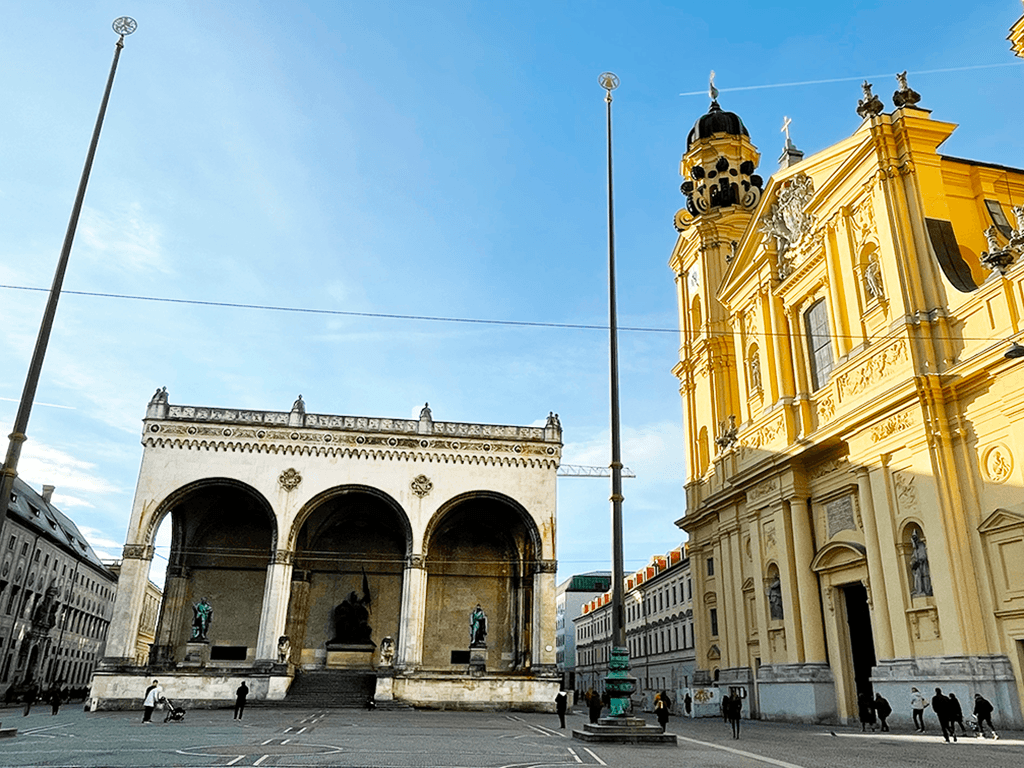
After the garden tour, we visit the Münchner Residenz, one of the largest royal palaces in Europe. The complex was built at the behest of Duke Wilhelm IV to replace the Neuveste – an old fortress – but over the years it has been extended and renovated several times. Today, the Residence is one of Munich’s most beautiful museums with more than 130 rooms open to the public and a mix of different styles ranging from Renaissance to Neoclassical, Baroque to Rococo.
From the plan we should have continued the tour with a walk in the English Garden, of which theHofgarten is a natural continuation, but because of the bad weather we decide to ‘skip the stop’ – and put it on our TO-DO list – and head into the centre. On the way we pass a small courtyard with a loggia and a very unusual tower: this is theAlter Hof, the old royal palace. Most of the palace wings were destroyed during World War II and later rebuilt. The Old Court wing houses a museum and the Information Centre.

It’s lunchtime and we dive into the Viktualienmark, Munich’s most famous and oldest city market. The market, which occupies about 22,000 square metres, has 140 stalls selling all kinds of foodstuffs, Christmas decorations and ornaments, household items, flowers and spices. The area is very lively and full of kiosks, restaurants and pubs all around. The perfect place to take a break.
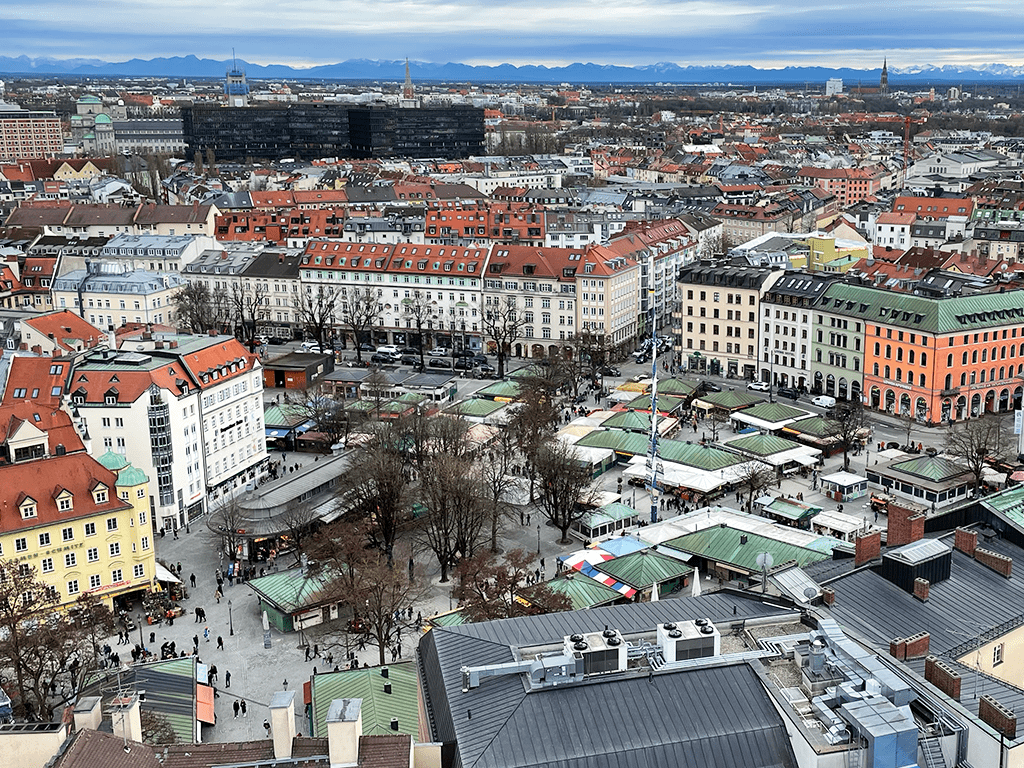
Behind the market you can already catch a glimpse, and it is one of the stops I have been waiting for the longest! The first peak of this trip is theAlter Peter, the bell tower of the beautiful Peterskirche, and I’m not in the mood, Paolino is already snorting loudly. The bell tower is roughly 96 metres high and it takes ‘only’ 306 steps to reach one of the best vantage points from which to admire the city from above.
We also visit the Peterskirche, Munich’s oldest parish church. The church is in late Baroque and Rococo style. Inside you can admire an impressive Baroque altar and in one of the side chapels is a shrine with the skeleton of St Munditia, the patron saint of single women.
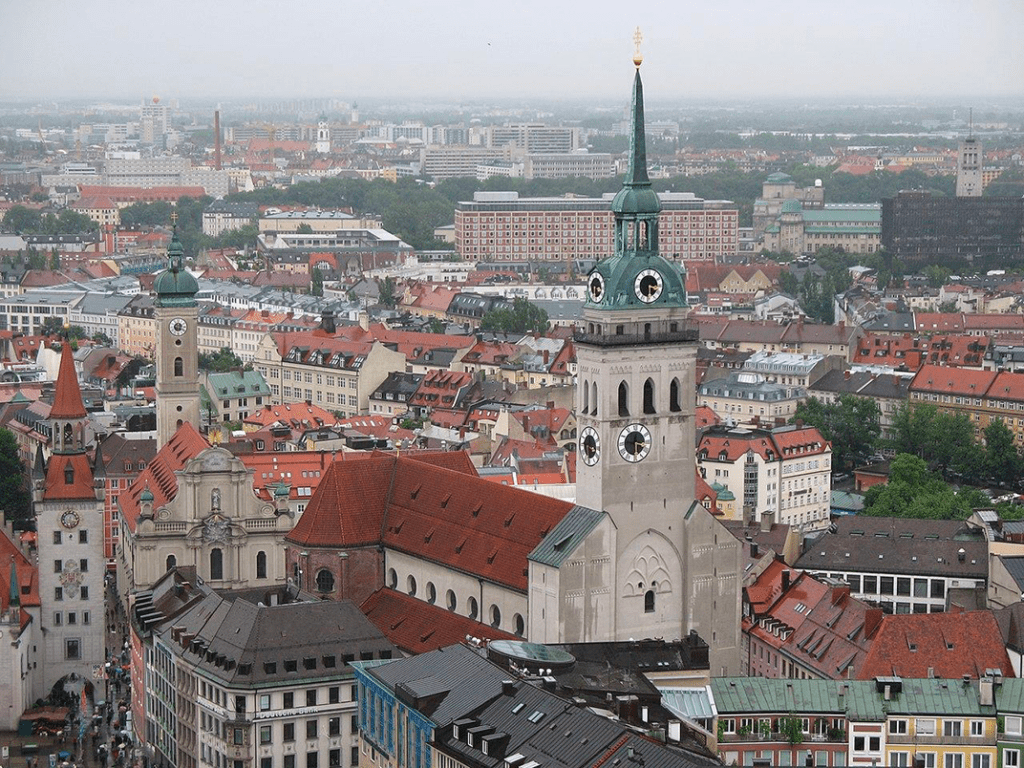
We walk down Sendlinger Straße to number 32 where we find one of the hidden gems of the city, the Asamkirche. The religious building, also known as the Church of St. John of Nepomuk, was built by the Asam brothers as a private place of worship and later opened to all. The entrance portal is decorated with bas-reliefs depicting St John. Inside, the main nave is rich in frescoes, stucco work and sculptures. The high altar houses a glass sarcophagus with the remains of St. John of Nepomuk. Attached to the church is the Asamhaus, another masterpiece by the Asam brothers. The façade of the building is decorated with stuccoes representing the arts and sciences, Athena, Apollo, the muses and further allegorical figures.
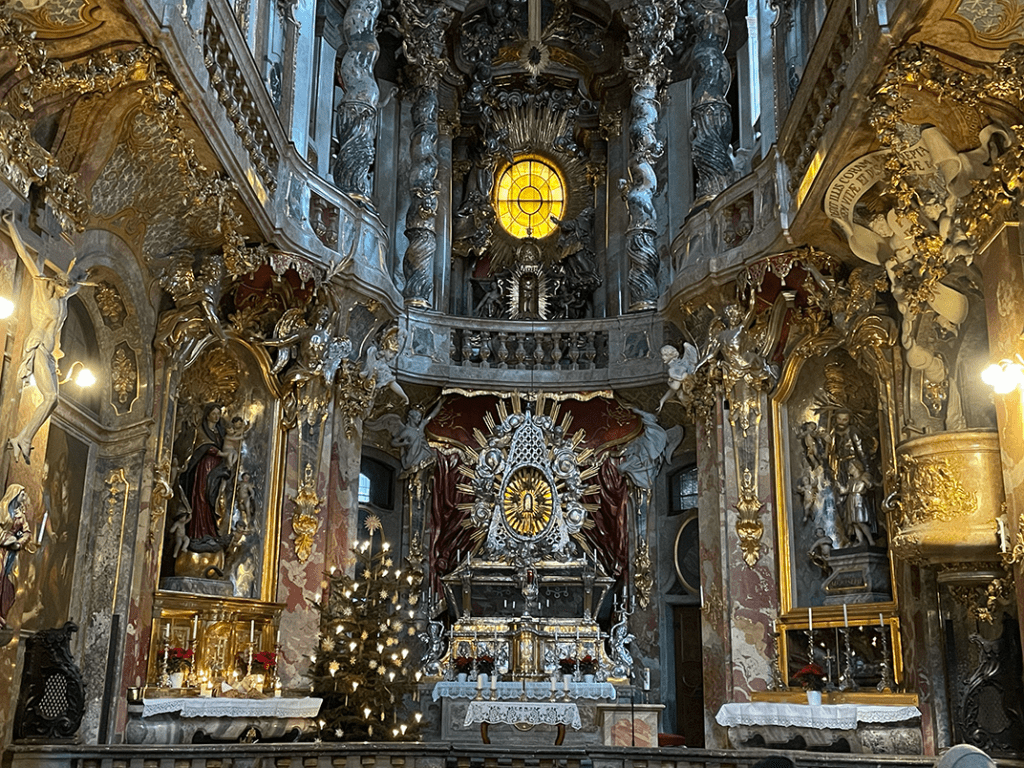
We return towards the centre and visit the Frauenkirche, which is also known as the Cathedral of Our Lady. The church is known for its nearly one hundred metre high bell towers covered with copper domes. The church was badly hit by bombing during World War II, but the towers remained unscathed and look over 400 years old.
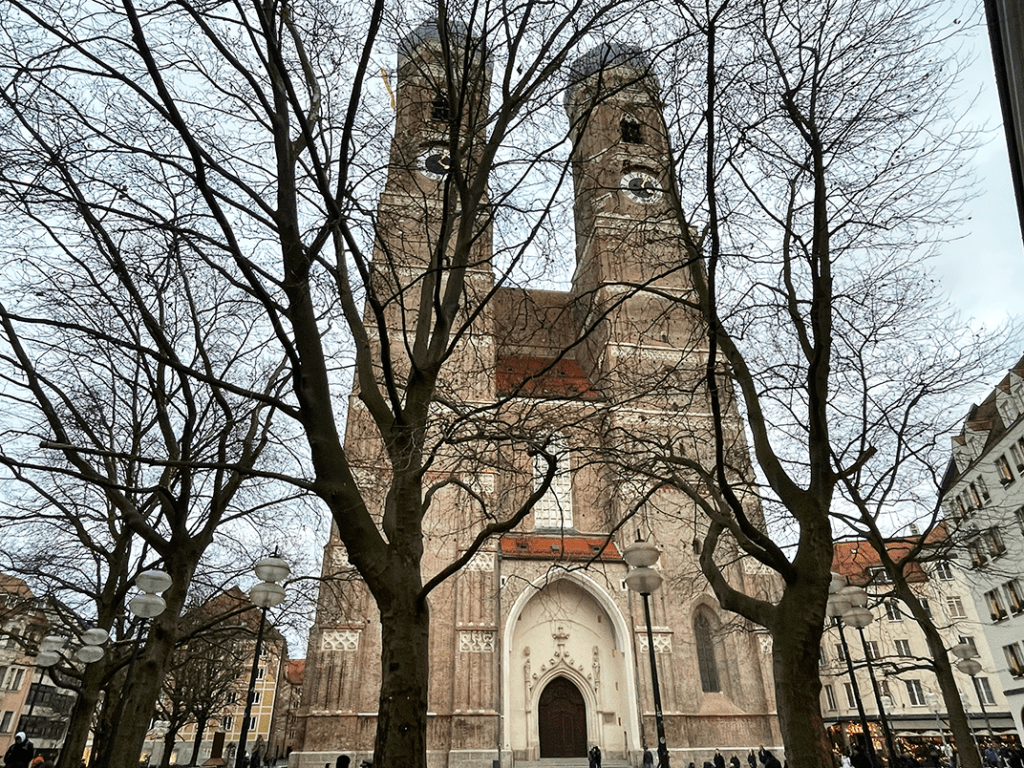
Finally, we head to the heart of the city, Marienplatz, the most famous square with the Mariensäule, the column of the Virgin, and theAltes Rathaus, the old town hall, at its centre. This is also overlooked by the beautiful Neues Rathaus, the neo-Gothic town hall with its Clock Tower and its Carillon, which is played twice a day in winter (Nov-Feb. 11am and 12pm) and three times a day in summer (Tue-Oct. 11am, 12pm and 5pm). Of course we can’t miss a visit to the palace and the Tower, no steps to climb, just a lift, for the other long-awaited stop!
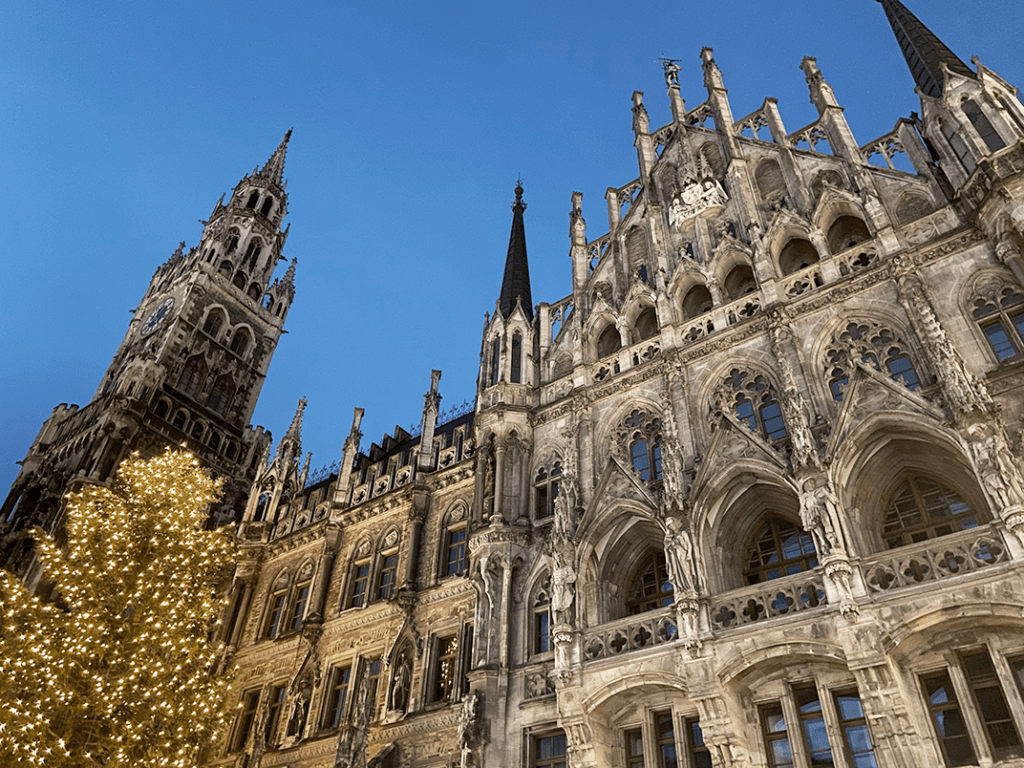
Our day ends with dinner in true Bavarian style atHofbräuhaus, the city’s most famous brewery. Its brewery is part of the ‘seven sisters’, the seven historic breweries of the region. The brewery was commissioned by Wilhelm V who wanted to brew beer for his army. Today, it is not only a brewery but also a good restaurant where you can enjoy typical dishes. The walls are frescoed with scenes of folk life while the staff is dressed in traditional Bavarian clothing. The ambience is very special, characterised by typical music, singing by the diners and much laughter between tables shared by strangers who are friends at the end of the meal.
Day 4: Chiemsee – Herrenchiemsee Castle
We leave Munich and make our way to Herrenchiemsee Castle, the ‘Bavarian Versailles’. The castle is located on the Herreninsel island in the Chiemsee lake. To reach it, we take the ferry from the pretty village of Prien am Chiemsee.
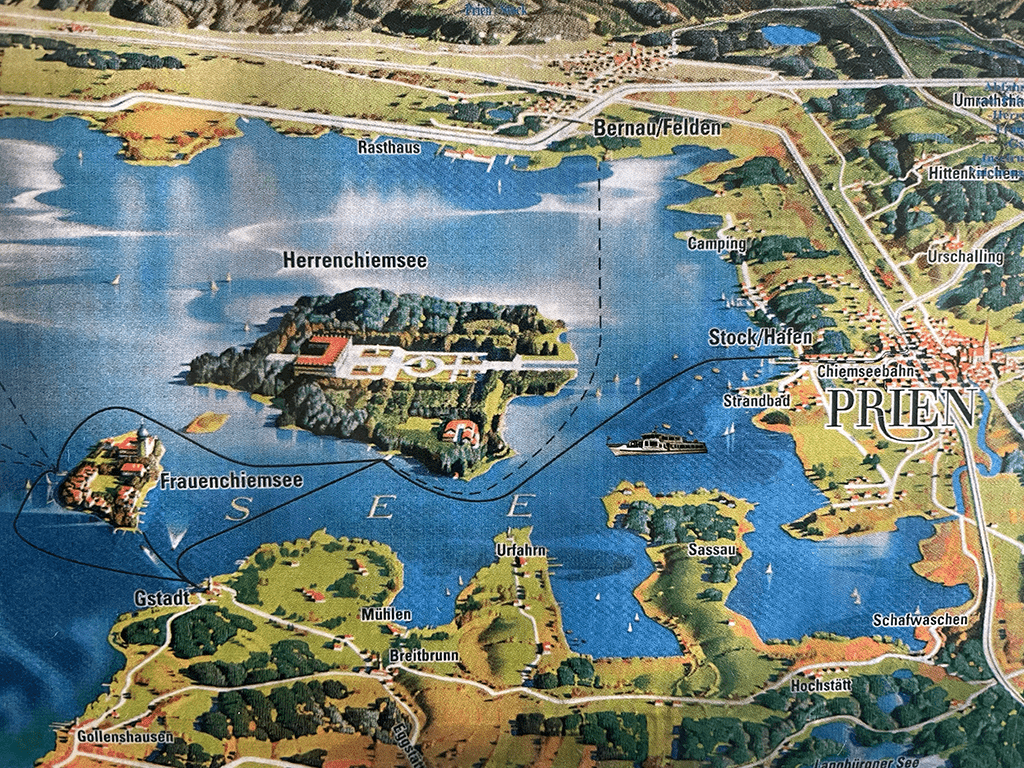
The façade is an exact copy of that of Versailles: Herrenchiemsee is presented as a hymn to the power and glory of the Sun King, Louis XIV of France, and Ludwig II, always an admirer of this mythical historical figure, decided to erect a castle that was an exact copy of the French original. The construction of this, combined with the expenses incurred for other palaces, practically ruined the king, who in spite of this spent only 10 days in Herremchiemsee. The palace was never completed: at the time of the king’s death, 50 rooms still remained to be built. The unfinished left wing was later demolished while the right wing was never built.
A visit to this château is a walk through opulence, unbridled luxury, but also the king’s fantasies and obsessions. Everywhere there are references to Versailles, both in the design of the palace and in the furnishings, with busts of Louis XIV and other French nobles of the absolutist era. Even here there is no lack of extravagance and whimsy typical of the king. The Great Hall of Mirrors was lit by more than 30 glass chandeliers and more than 50 candelabras with a total of 7000 candles, which took 70 servants half an hour to light. In the room, at the foot of the bed, he had a blue glass globe installed to illuminate the room with a soft blue light. In the dining room, we find the Tischlein-deck-dich, a dining table that, by means of a system of pulleys, disappeared into the floor to the floor where the kitchens were located. In this way the table could be set without the king being disturbed by the servants during the meal.
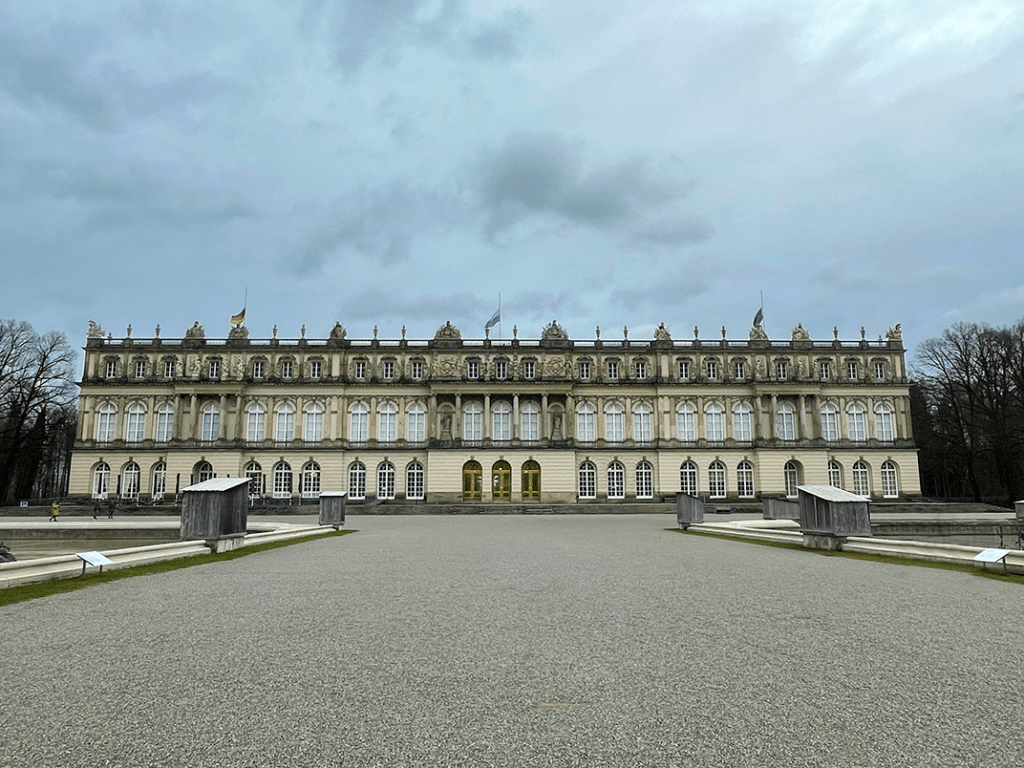
Before leaving, we stop in the harbour of Prien am Chiemsee, eat in a little restaurant with a view of the lake and take a walk along the quay.
In the late afternoon we arrive in Salzburg, just in time for a stroll through Getreidegasse, a busy shopping street in the historic Altstadt (Old Town), characterised by the medieval wrought-iron signs of the traditional old shops. From here, through courtyards and small squares, we begin to get acquainted with the city still under the effect of Christmas with its markets, trees and lights.
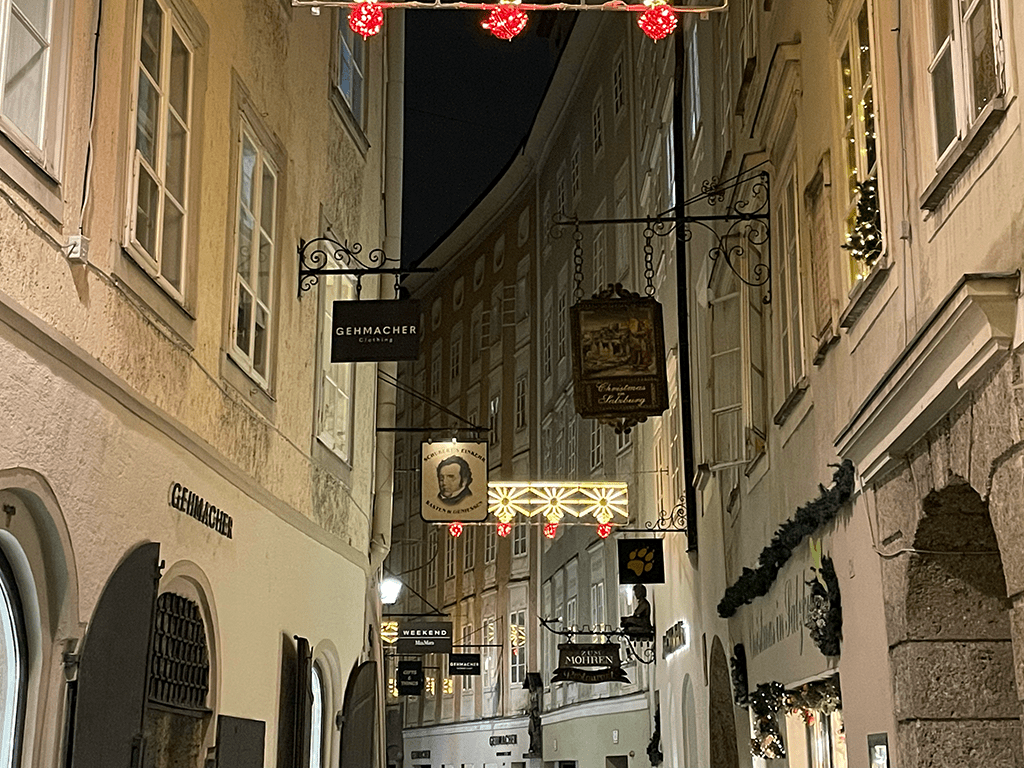
Day 5: Salzburg
Salzburg is a beautiful city in Austria. It enjoys a very special location at the foot of the Untersberg mountain and is washed by the Salzach River, which divides the heart of the city into the ‘old town on the right bank’ and the ‘old town on the left bank’ connected by many bridges. The city is a concentration of medieval streets, Baroque buildings and hidden courtyards. One only has to walk through the alleys of the old town to feel the elegance of Salzburg.
Tips for trips: To visit the city and many of its attractions, we bought the Salzburg Card. As well as allowing free entry, skipping the queues, to the city’s main sights – admission to the castle, Mozart’s house and the Domquartier is covered – it also includes free use of all city buses.
Our tour begins at Hohensalzburg Fortress, the symbol of the city. Situated above the highest part of the Festungsberg, it dominates Salzburg, offering a splendid view over the rooftops of the city. To get to the top you can either take the funicular railway or take a scenic walk, which is a little challenging in places. We choose the funicular (the ticket is included in the Salzburg Card) and reach the courtyard. In addition to enjoying the wonderful view, we visit the fortress museum, the tower and the Rainer Regiment Museum. The third floor of the fortress also houses the Princes’ Rooms – a visit included in the Salzburg Card for admission before 11 a.m. -, the Golden Stube with the Majolica Stove and the Golden Hall with its original furnishings from the 1500s. Not to be missed is the panoramic tour, which leads from the salt storehouse through the basement to the viewing platform of the Reckturm, where there is one of the most beautiful views of the city. The tour then continues through the battlements to the famous Salzburg Bull. All along the way, the explorer’s notebook, and the little owl Albi, kept us company. Supposedly it is a little game for children where if you answer all the questions about the fortress and draw a friend for Albi you win a prize… we picked up the prize, a magnet.
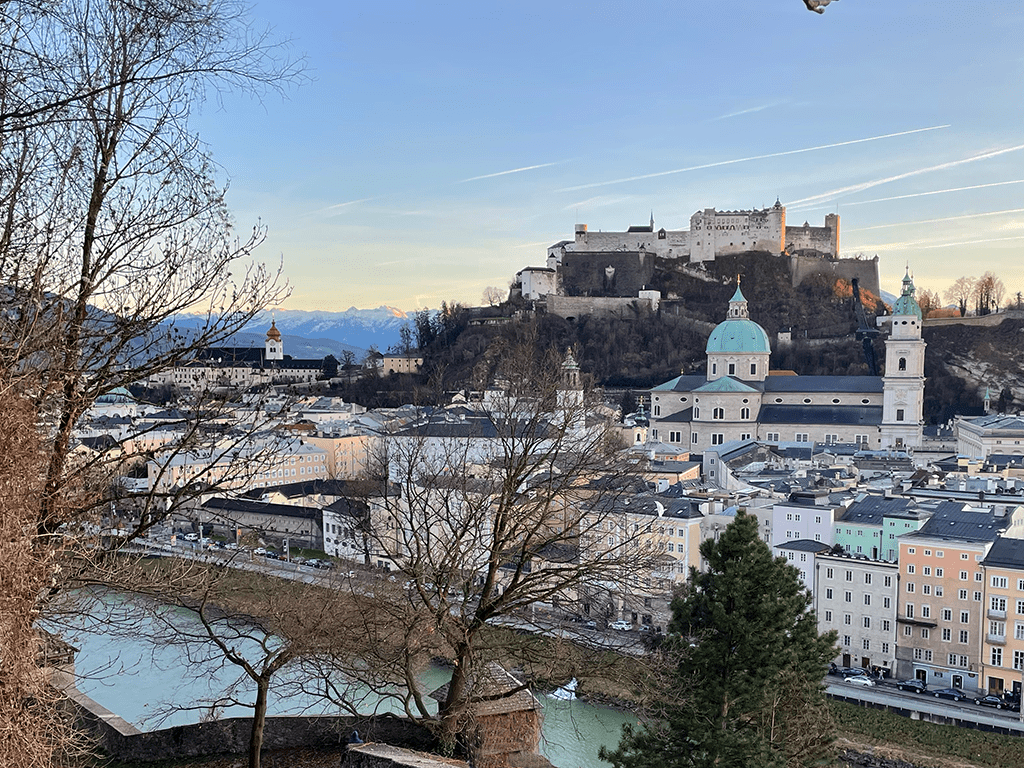
Descending from the fortress, we cross Kapitelplaz to Domplatz where theUntersberg, Salzburg’s cathedral, stands with its splendid façade and imposing dome. The cathedral has survived six fires and on the entrance gates are the dates of three consecrations of the church: 774, 1628 and 1959.
The nave, 101 metres long and 32 metres high, has a series of chapels on both sides, each with a specific altar. The high altar is made entirely of marble and houses an altarpiece illustrating the resurrection of Christ. The dome of the cathedral, 71 metres high, is divided into octagons painted with scenes from the Old Testament made in 1955 to copy the original paintings that were destroyed in the 1944 collapse. The crypt, built in Romanesque style and dating back to the design of the first cathedral, houses the bodies of many of Salzburg’s archbishops, which are sealed by pink marble slabs engraved with their names and surmounted by the archbishop’s coat of arms.
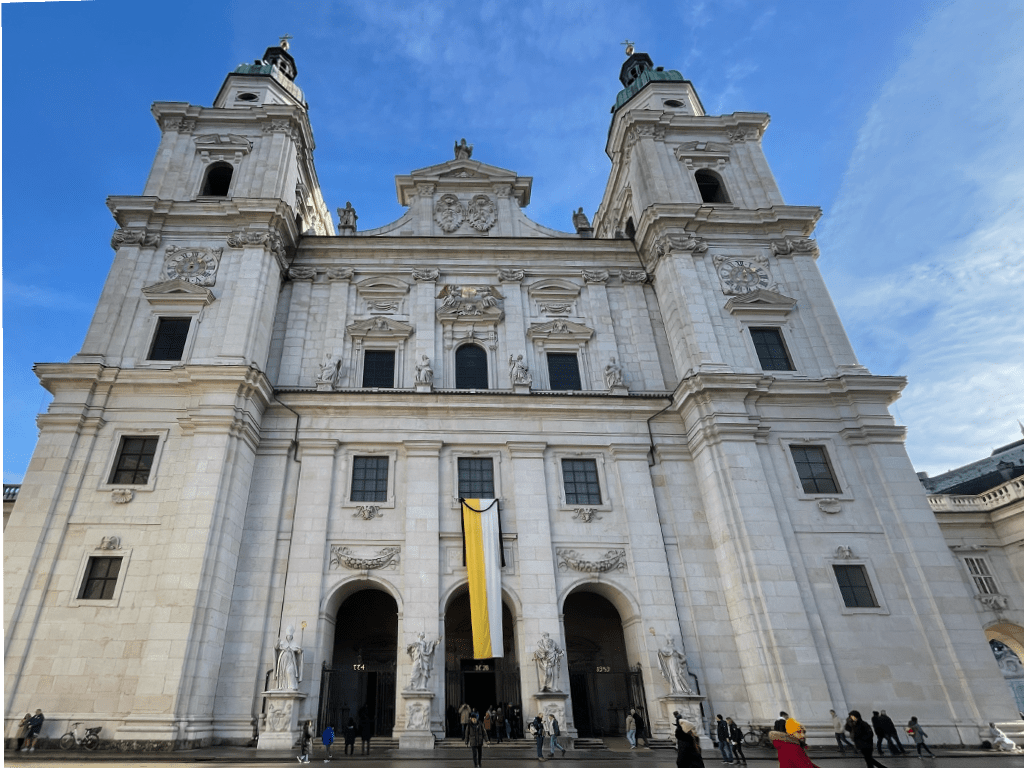
We move on to the nearby Residenzplatz – the third square bordering the cathedral – where the DomQuartier is located, a cultural centre comprising the cathedral, the Residenz and the Benedictine Monastery of St. Peter. A single combination ticket – included in the Salzburg Card – includes the Residenz Halls, the Residenz Galerie and the Cathedral Museum, where you pass by the organ gallery with a beautiful view of the nave and Residenzplatz.
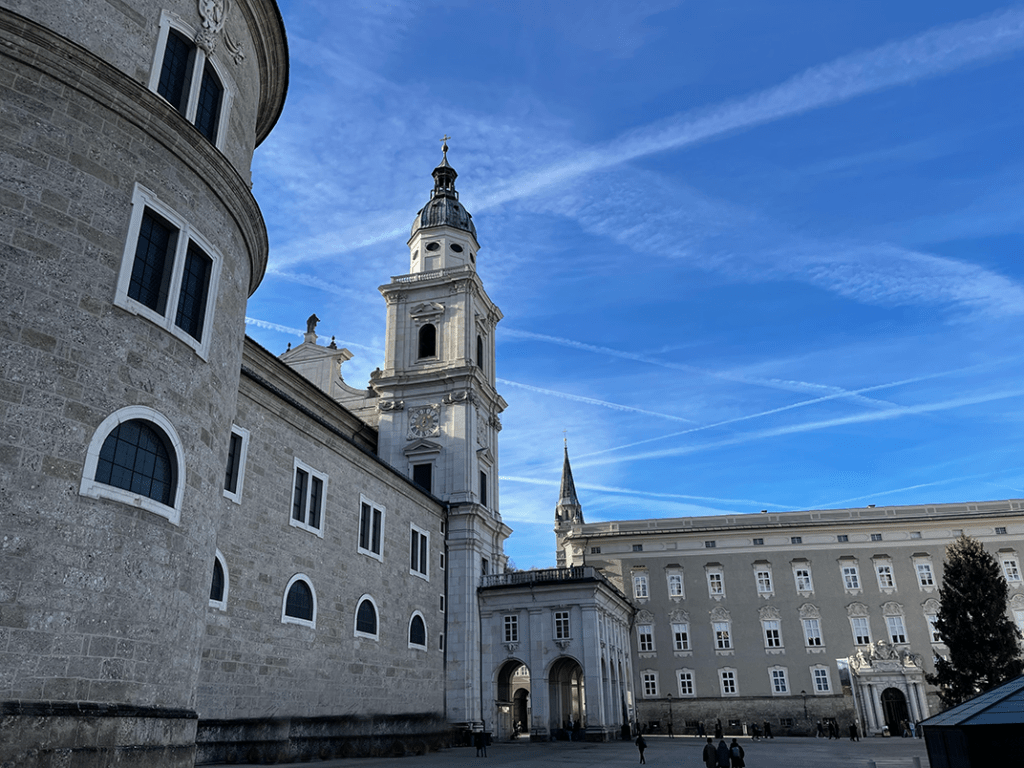
Starting at Mozartplatz, we cross Getreidegasse – this time during the day – to No. 9 where there is an exceptional bell: in 1756, Salzburg’s child prodigy, Mozart, was born here. Today it is home to the Mozart Museum, which has been on display since 1880. Today, not only the musical instruments of the young Mozart are on display, but also furniture, paintings, family letters and autographs. We find it a bit disappointing and not very organised. We decide to console ourselves with a tasty lunch in a typical restaurant.
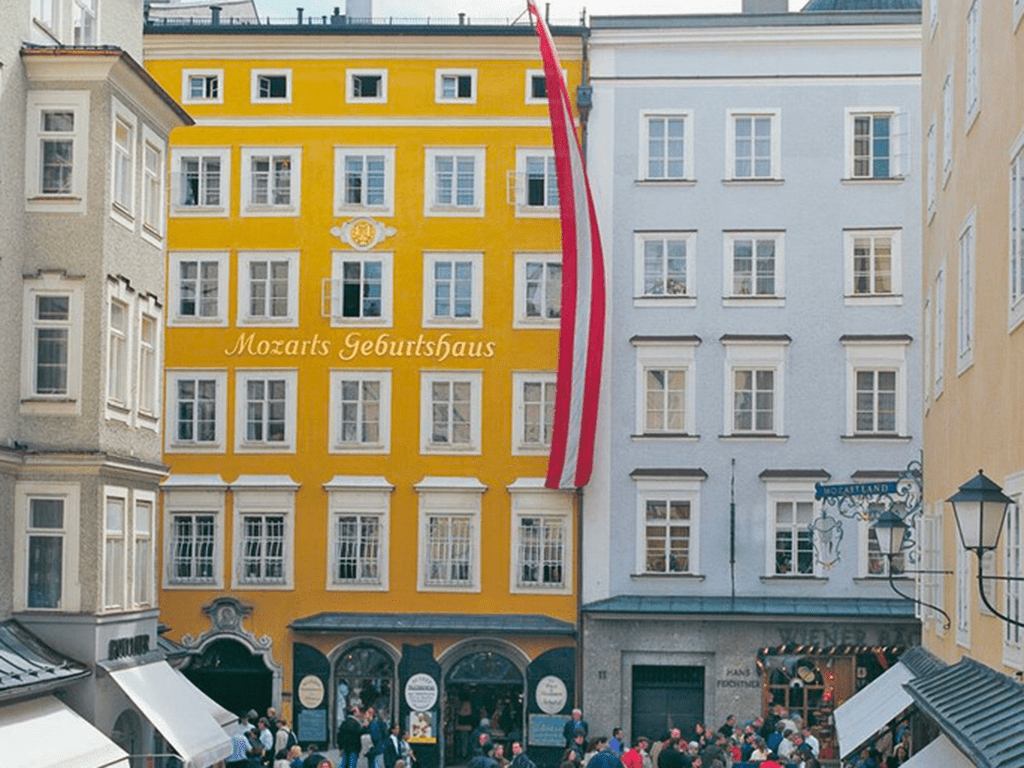
After lunch, we take a long walk along the Salzach and move to the right bank. We are very impressed by the houses carved into the rock that seem to disappear inside it.
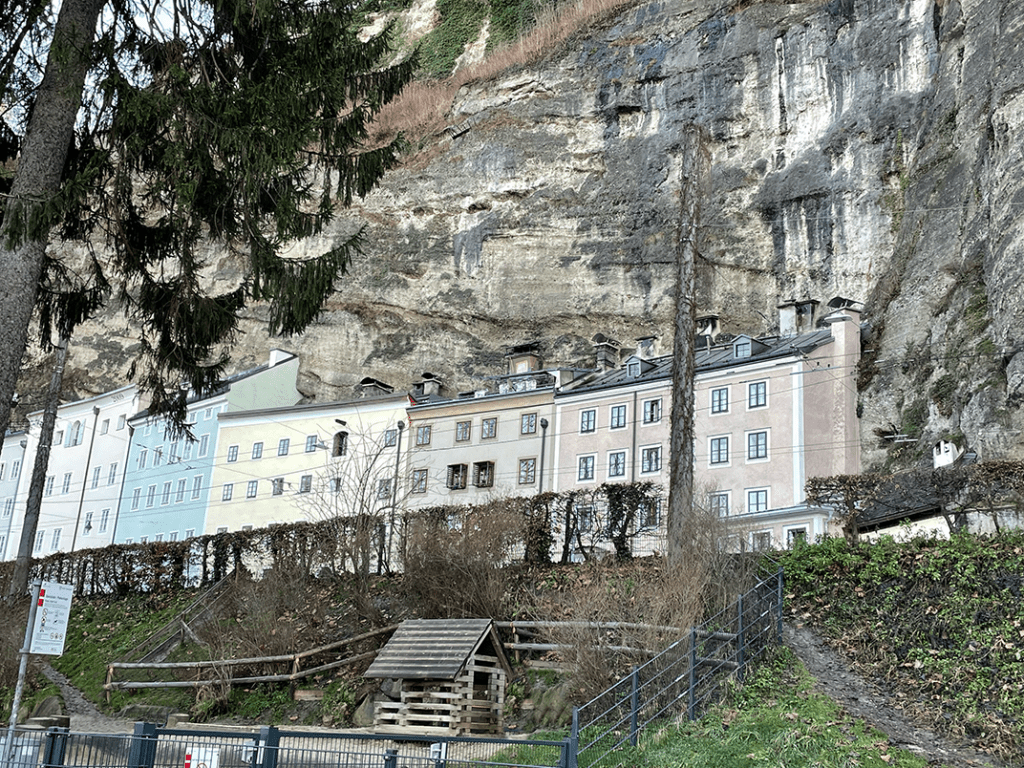
From Makartplatz, through the gap between the Landestheatre and the hotel, the Mirabell Gardens open up. The fountain in the centre of the garden is surrounded by four large marble groups symbolising the 4 elements of nature. A few steps up from the Pegasus Fountain lead to the Dwarf Garden. In winter some parts are closed to tourists, but it is always worth a walk.
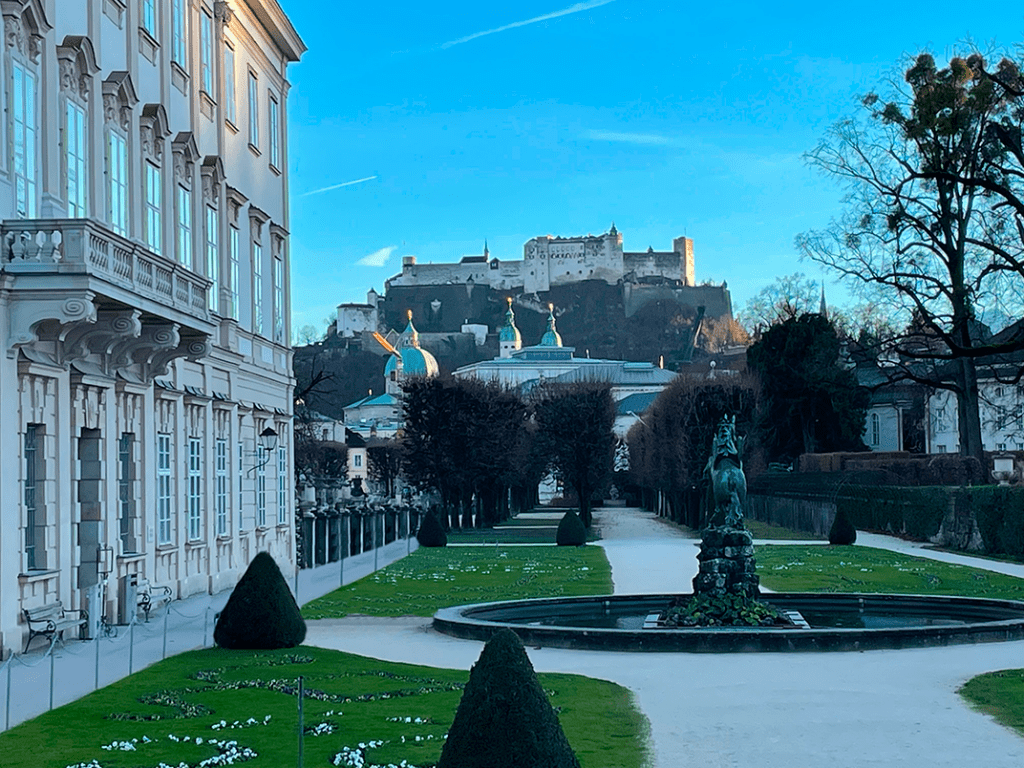
We walk back from Makertplatz to no. 14 Linzergasse, pass through a gateway dating from 1617 and walk up the steep slope – where we find statues representing the Stations of the Cross – to the Kapuzinenberg mountain and the Capuchin monastery. Many trekking routes around the mountain start from here. Around the convent, there are many viewpoints with a splendid view of the city and the fortress. We return down via an alternative route: a steep but shorter staircase that takes us directly to Linzer Gasse Platzl, a small square full of kiosks and shops. We end the day with a Weihnachtspunsch.
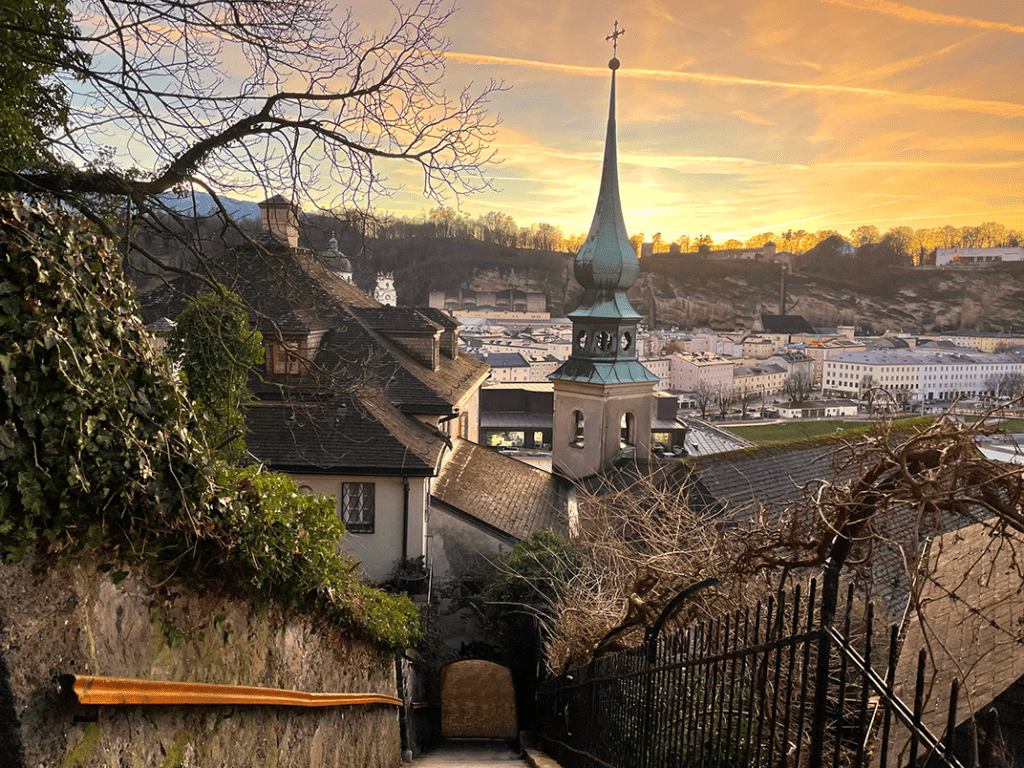
Day 6: Innsbruck
Today is the day of return, but we break up the journey with a first stop in Terfens, 25 kilometres from Innsbruck. Here is Haus Steht Kopf, the upside-down house designed in 2012 by Polish architects Irek Glowacki and Marek Rozanski. Once inside we are catapulted into a parallel world where everything is turned upside down, even walking through the rooms becomes a real challenge. It is not only the house that is upside down but also all the furniture and objects are hung from the ceiling. The floors in each room change inclination, conveying a sense of instability that makes the visit even more fun!
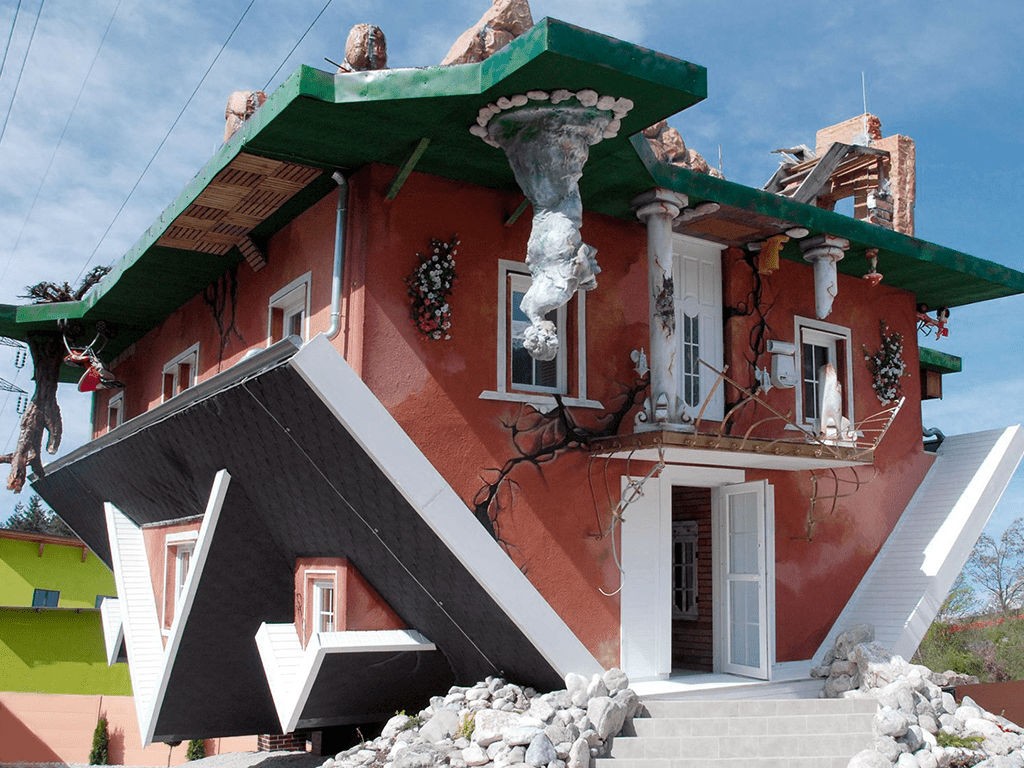
As a last stop, we visit the quaint town of Innsbruck, Austria. We pass theTriumphal Arch that marks the entrance to the city, built in 1765 for the wedding of Archduke Leopold.
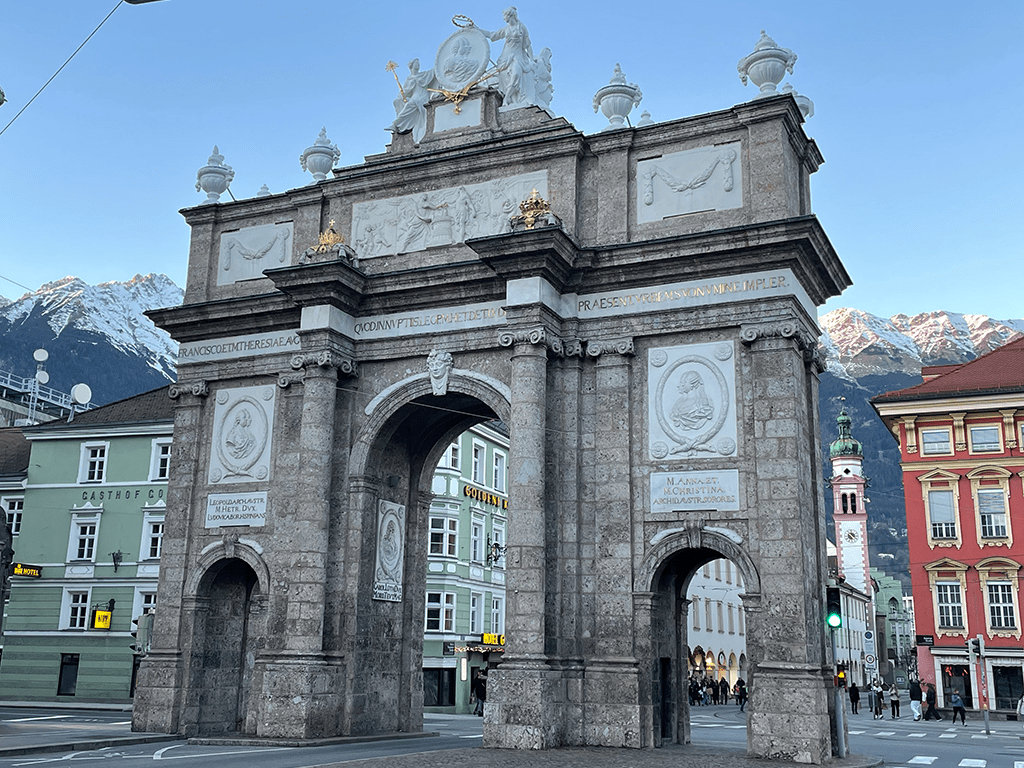
We stop in Maria-Theresien-Straße for lunch. This street is one of the best known in Innsbruck, surrounded by colourful buildings, shops and cafés. In the centre of the square is St Anne’s Column, a monument depicting St Anne and the patron saints of the Tyrolean lands. The Church of the Holy Spirit Hospital (passing through the centre) is also worth a stop.
We walk through the old town to Herzog-Friedrich-Straße 15, home to the Habsburg Residence with its famous Golden Roof, a roof covered with 2657 golden tiles, the symbol of Innsbruck.
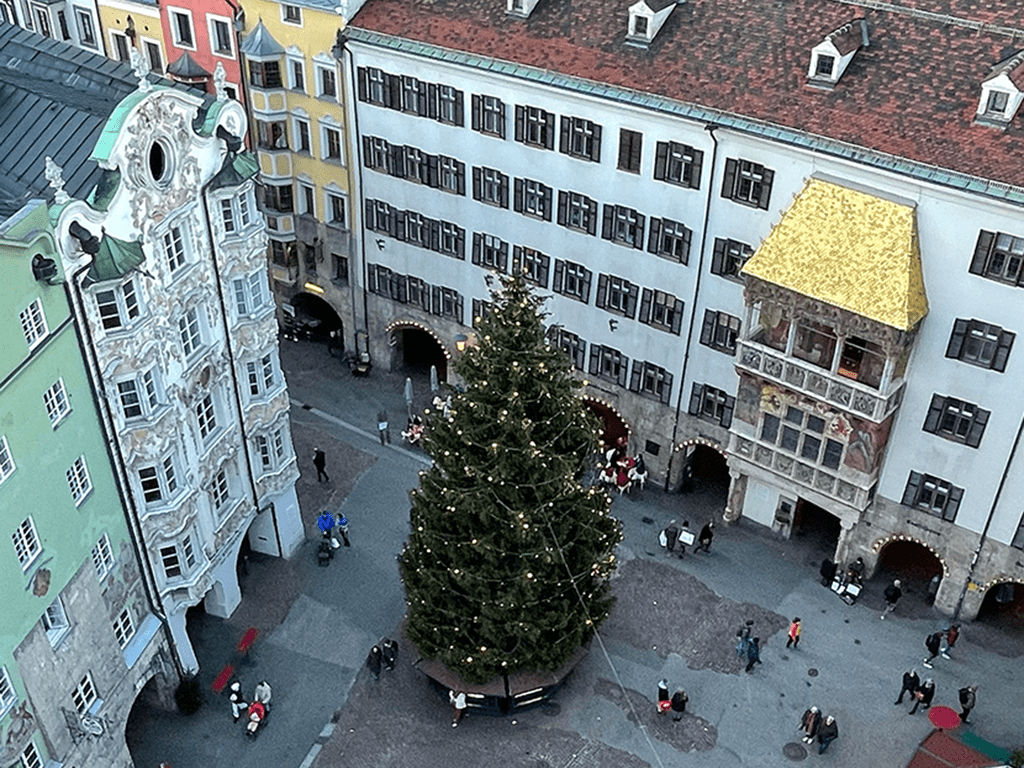
We end our holiday on a high note with a ‘climb’ to the Civic Tower, located just a few steps from the Golden Roof. Climbing 133 steps, we reach the top, from where medieval sentinels kept an eye on the city. The view sweeps from the alleys of the old town to the snow-capped mountain peaks around the city.
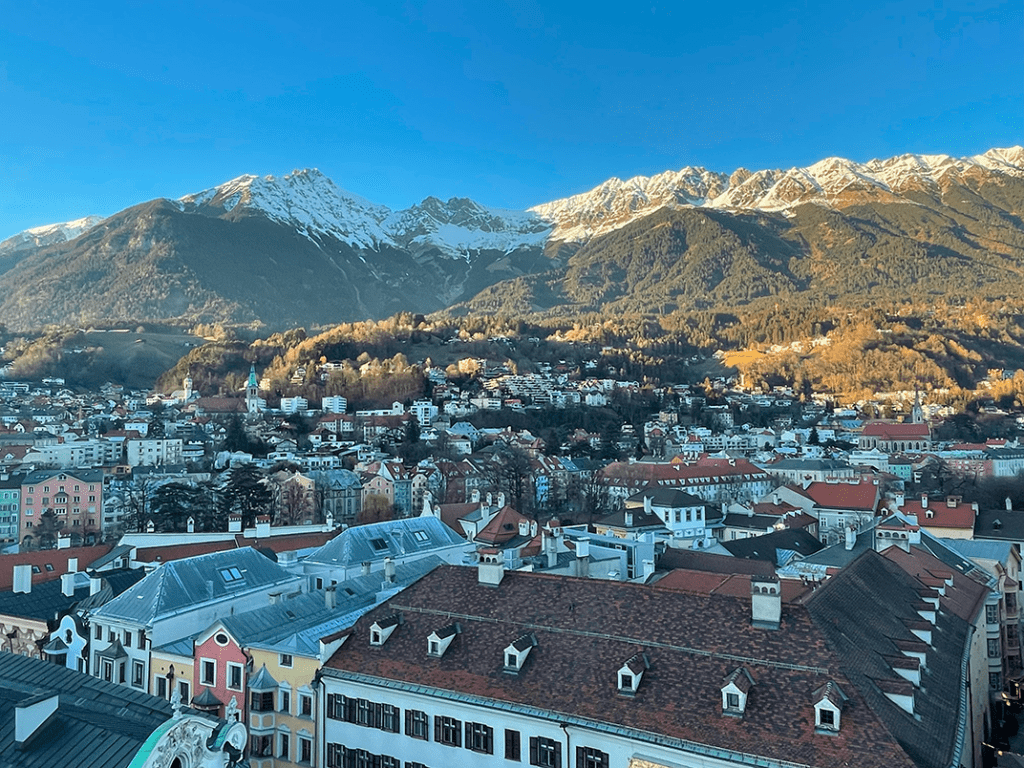
And now we set off home, a little tired, but satisfied! The beauty of the places we saw is unquestionable and can be appreciated in any season, but probably, without the magic of snow, it is better to visit these places during warmer periods so that we can admire them among the flowers and fountains.
Last modified: 14 June 2025
